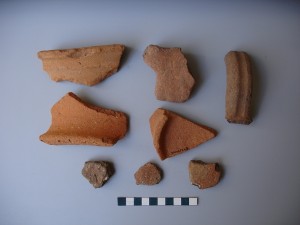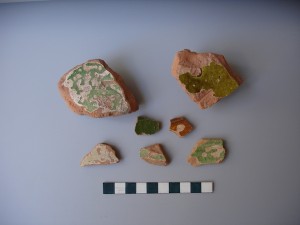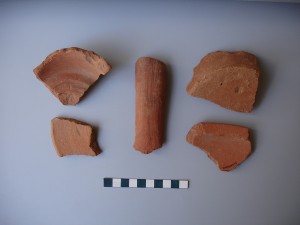The 2009 season of the suburban survey pottery study started on June 14th, under the supervision of Prof. Jeroen Poblome. The aim of this pottery study is to determine the character, function and date of the ceramic finds recovered from the suburban survey conducted by Hannelore Vanhaverbeke during the 1999-2004 campaigns.
We started with the sites located between Sagalassos and AÄŸlasun and to the North-East of AÄŸlasun: Manastır 2003 – Akyamaç 1 2004 – Susaklı 2004 – South Area 2004 survey unit collections. The sherds are counted and weighed individually, upon the determination of their chronology, typology and fabric, using a specifically designed pottery template. Several phases could be distinguished in the pottery collected at the surface of these sites from Classical/Hellenistic into Ottoman times. The assemblage consisted of a variety of mainly regional fabrics for household and table wares.
The pre-Roman period is dominant in the Susaklı material and contained storage vessel, jar, jug, cooking pot, lid, dish, bowl body, base, rim, and handle fragments, as well as tile fragments. Some of the material is decorated with incised lines and applied bands. In general, the material could be attributed to the Classical/Hellenistic period, extending the potential of studying the contemporary occupation in the region. As the material is contemporary to and of the same nature as that on Tepe Düzen and at Sagalassos, possibly a rural dimension can be added to the Classical/Hellenistic occupation of the region.
The Roman period material is dominant in the so-called South Area and is mostly restricted to Sagalassos Red Slip Ware, representing table and serving wares, whereas also some cooking pots, storage vessels, amphora/jars, jugs, oil lamp, tile and water pipe fragments were counted, albeit in much smaller quantities. The material of this period contained few imported amphorae as well as a small quantity of table and cooking ware fragments of different fabrics. Most of the pottery is datable to the high imperial-Late Roman period, with a lower representation of early imperial and Phase 9 (550/75 AD – 640/50 AD) material.
The Early Byzantine period, including the so-called “Dark Ages” (mid 7th-9th centuries), is represented by only few pattern burnished jar/jug body fragments. The Byzantine period material is mainly attributable to the Mid Byzantine (11th/12th-early 13th centuries) period and represents coarse wares, such as jars, jugs, cooking pots, storage vessels rim, base, body and handle fragments and a very small quantity of pattern burnished and glazed wares are present. Body fragments are sometimes decorated with incised straight and wavy lines and an applied and incised band. The Late Byzantine period (mid 13th-14th) is represented by only few jar/jug fragments.
Most of the Ottoman period material consisted of fragments of thick walled, flat based, strap handled jars/jugs and cooking pots with simple rims, in oxidized hard to very hard fired reddish-brown fabric(s), with a rough feel, sometimes powdery, hackly broken edges and moderate, mostly angular inclusions, which were dull white and shiny black in color, and including lime and mica fragments. Storage jars and pithoi body fragments are sometimes decorated with incised straight and wavy lines. Considering parallels from amongst others the Çanaklı workshops, most of the material can be attributed to the Late Ottoman and early Turkish periods. Following the limited presence of the different functionality of the material, it is difficult to determine the nature of the occupation. The glazed table and other wares are in a very small quantity, combined with the general paucity of open forms.
In the next weeks, the ceramological information will be combined with the spatial analysis of the material, in order to bring forward hypothesis of the nature of the suburban occupation. So far, the suburban zone looks very promising to capture the pulse of the regional occupation through time, and is expected to reveal important aspects with an effect on the general interpretation of Sagalassos and its territory.




